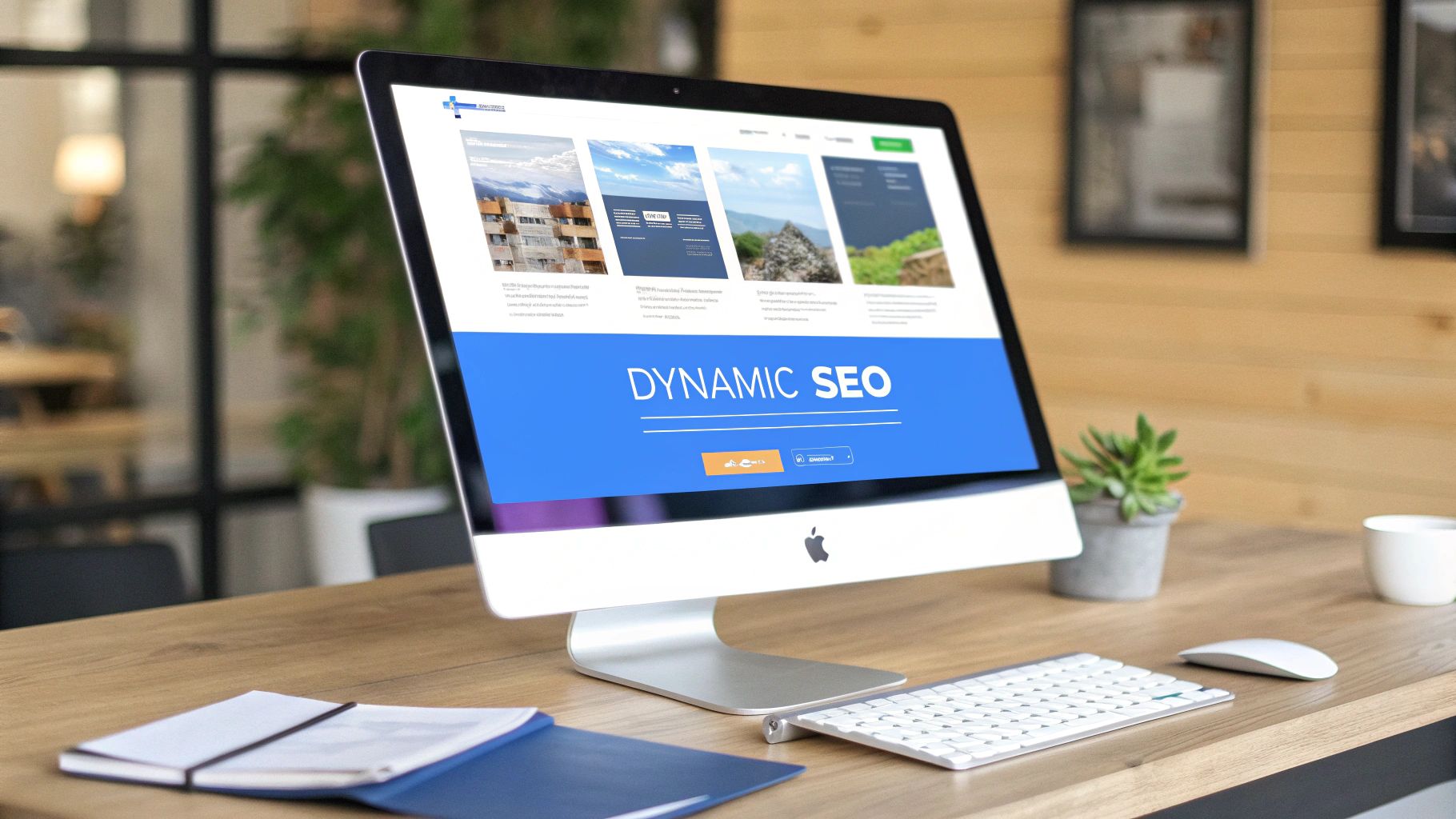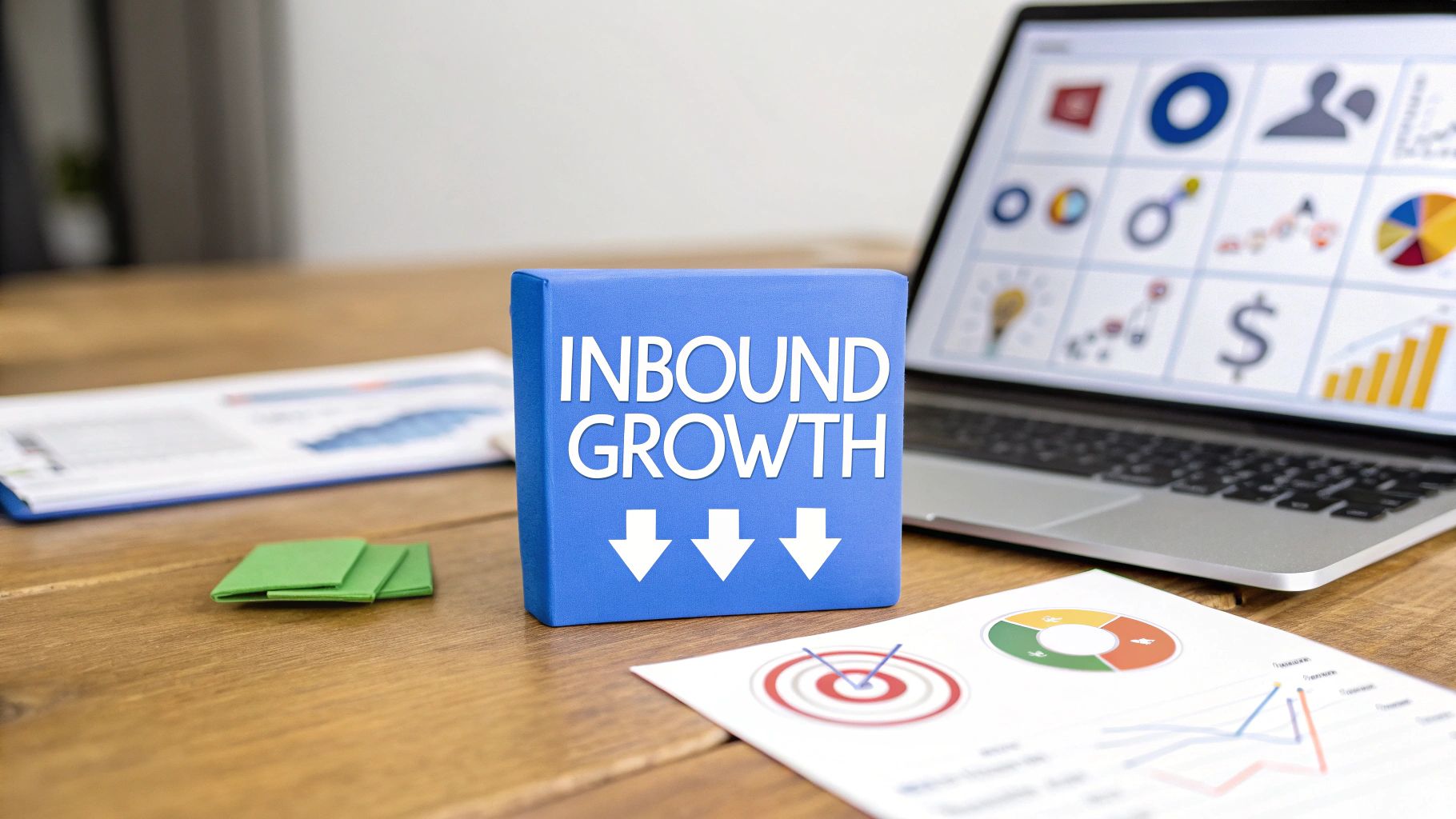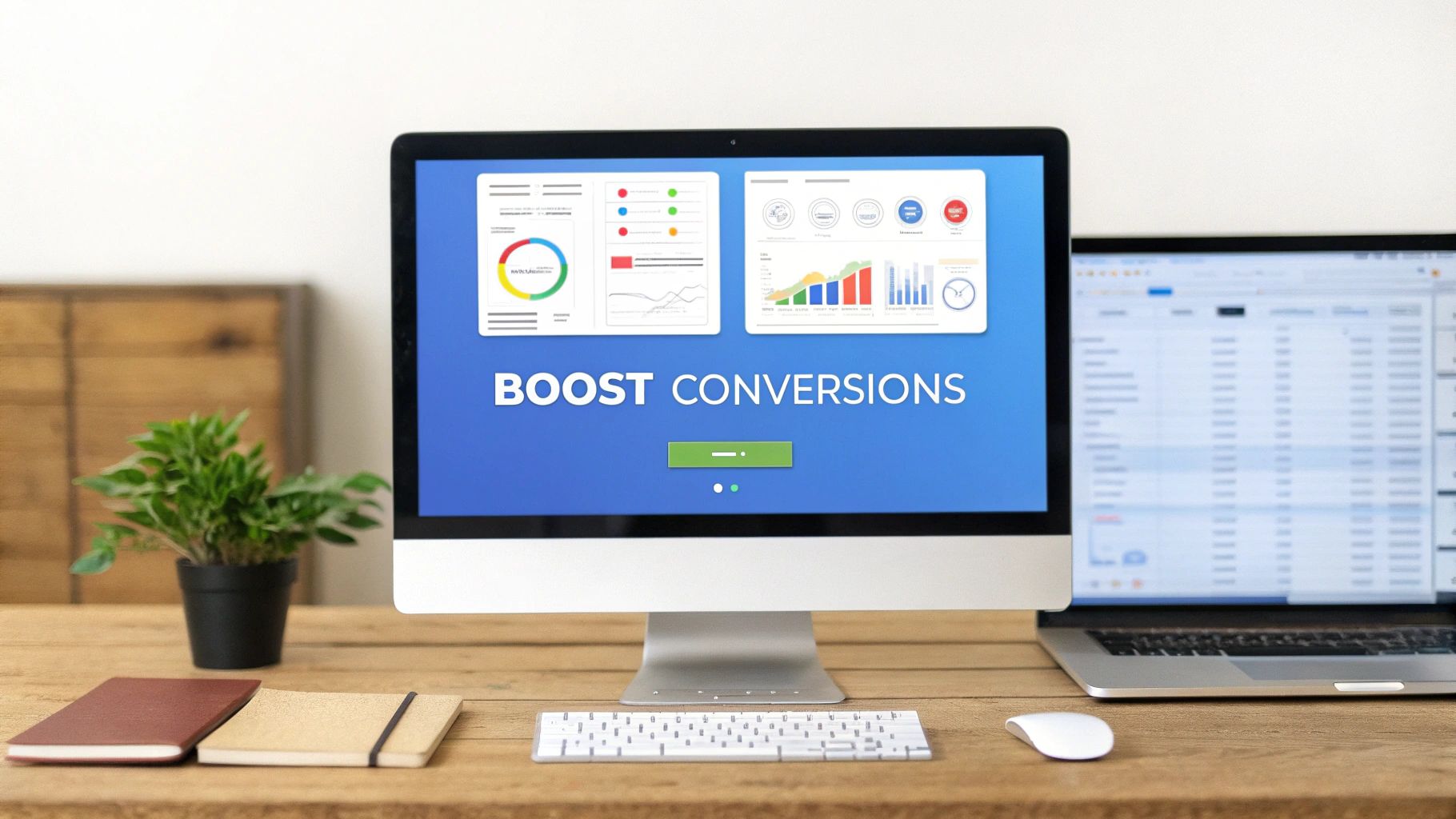Summary
Meta Description: Boost rankings with dynamic content SEO. Learn to personalize user experiences, lower bounce rates, and master technical challenges for top performance.
Dynamic content SEO isn't just another marketing buzzword. It's a fundamental shift in how we approach websites. Instead of serving the same generic page to every visitor, it’s about creating a smarter, more personalized experience that changes based on who is visiting. What's the difference? It's like a one-size-fits-all t-shirt versus a tailored suit. Which one do you think makes a better impression?
What Is Dynamic Content and Why It Matters for SEO
Think of your website as a smart, intuitive assistant. When a visitor arrives, this assistant already knows a bit about them—perhaps their location, how they found your site, or what they've looked at before. Instead of a generic greeting, it offers up exactly what they need at that moment. That's the magic of dynamic content.
Unlike a static site, which is essentially a fixed digital brochure, a dynamic site adapts. A first-time visitor from New York might see a special "Welcome!" discount, while a returning customer from California is shown recommendations based on their last purchase.
This isn't just a cool feature; it’s a game-changer for SEO. Google’s entire mission is to deliver the most relevant, helpful results. When your site custom-builds an experience that perfectly matches a user's needs, they stick around longer, click more, and are far more likely to convert. Those are the exact signals Google loves to see.
How Dynamic Content Compares to Static Content
To really grasp the impact, let's break down the differences. A static website is like a printed sign—it says the same thing to everyone. A dynamic one is like a digital billboard that changes its message for every car that drives by.
Here’s a clear comparison of how these two approaches stack up for SEO and user experience:
As you can see, shifting from a static mindset to a dynamic one isn't just a minor tweak. It fundamentally changes how users interact with your site, which in turn sends powerful positive signals to search engines.
The Core Pillars of Dynamic Content
At its heart, dynamic content is powered by two simple but powerful ideas: personalization and relevance. They work together to create an experience that feels like it was made just for the visitor. Are you ready to dive deeper? This guide on What Is Dynamic Content is a great resource.
The infographic below really brings this relationship to life, showing how these concepts fuel a successful strategy.
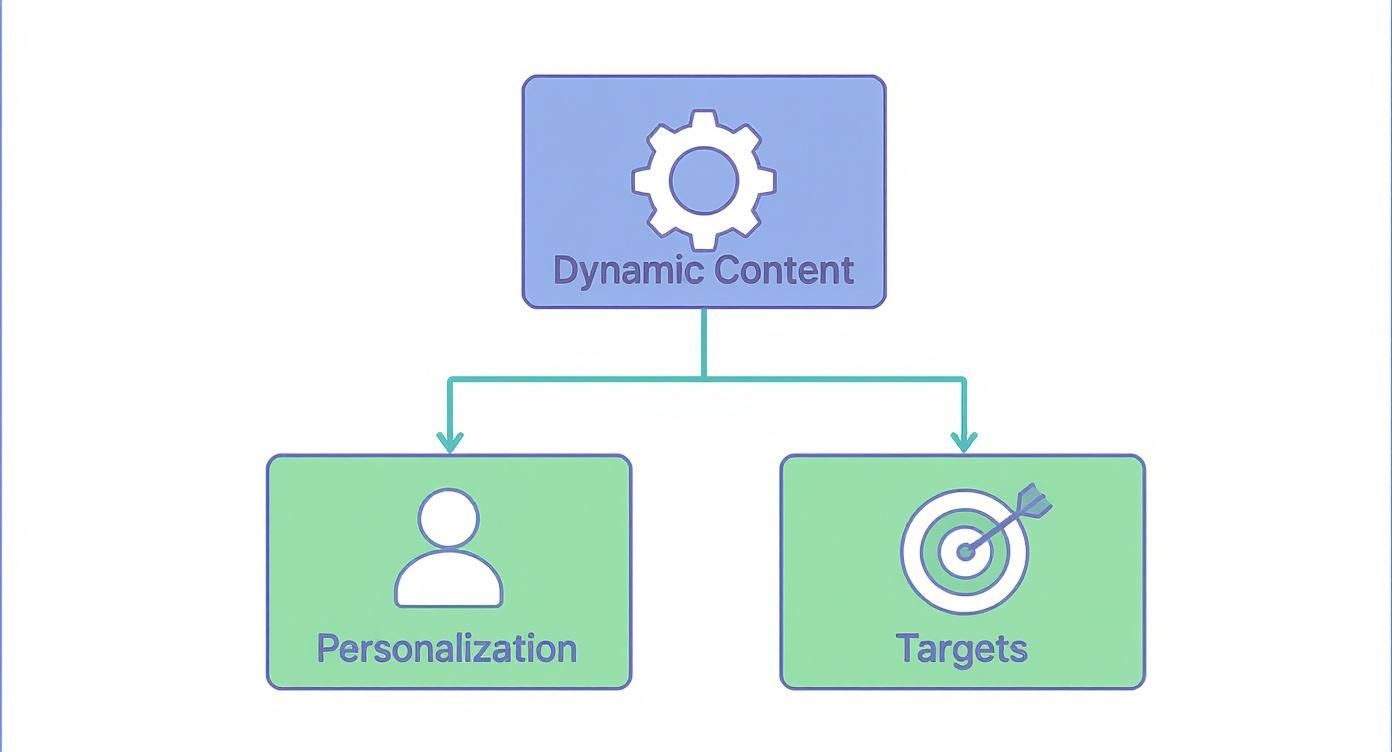
It’s a feedback loop: the more you personalize the experience, the more relevant your content becomes. And the more relevant your content is, the more satisfied your visitors will be.
Connecting Dynamic Content to SEO Wins
So, how does all this charm and personalization actually translate into higher rankings? It all comes back to user intent.
Google is obsessed with giving people the best possible answer to their query. When you use dynamic content, you're essentially helping Google do its job better. Here’s how:
- Lowering Bounce Rates: When a visitor lands and immediately sees something that speaks to them, they have no reason to hit the "back" button.
- Increasing Time on Page: A personalized experience is an engaging one. It invites users to click around, explore, and spend more time with your brand.
- Boosting Conversion Rates: Showing the right person the right offer at the right time isn’t just good service—it’s smart business. More conversions follow naturally.
These are not just vanity metrics; they are powerful signals that tell search engines your site is a high-quality, valuable resource. This is especially true for dynamic search results like featured snippets, which command a massive click-through rate of 42.9% compared to other organic listings. It proves that when you deliver precisely what the user wants, you win.
How Personalization Boosts Your SEO Performance
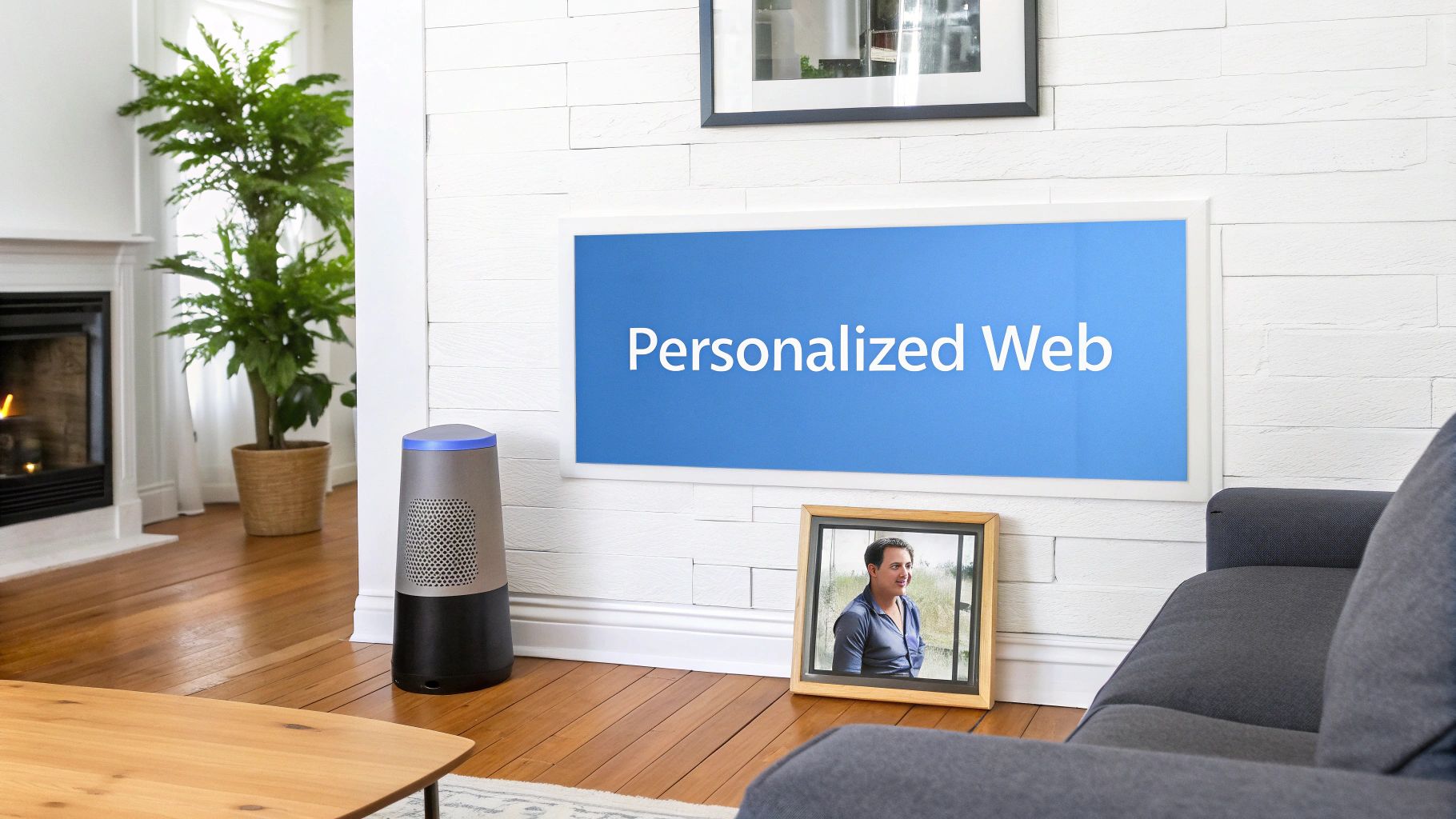
Let's move past the theory. A solid dynamic content strategy has a real, direct impact on the performance signals that search engines love to see. When you personalize the user journey, you aren't just creating a slick customer experience—you're actively fortifying your website's SEO foundation.
Put yourself in Google’s shoes for a second. Its entire mission is to give users the most relevant content for their search queries. Personalization nails this at a micro-level, kicking off a powerful feedback loop that gets you noticed.
Lowering Bounce Rates and Increasing Dwell Time
When a visitor hits a page that immediately connects with what they need, that instinct to hit the "back" button vanishes. Instead of some generic welcome mat, they're greeted with content that feels like it was made just for them.
Think about an e-commerce site showing a returning visitor the items they last viewed. Or a "You Might Also Like" section that actually makes sense based on their purchase history. That simple touch creates an instant connection, encouraging them to stick around, click through, and interact.
A lower bounce rate and longer time on page are strong positive signals sent directly to search engines. These metrics prove that your site is delivering value and successfully matching user intent, which is a critical factor for achieving higher rankings.
This kind of engagement isn't a happy accident. It’s the direct result of a well-played dynamic content SEO strategy that puts the user first.
Driving Conversions and Building Brand Trust
Personalization doesn't just feel good; it has a serious effect on your bottom line. By tailoring calls-to-action (CTAs), product suggestions, and special offers, you can see a dramatic lift in conversion rates. A first-time user might get a "10% Off Your First Order" banner, while a loyal customer sees an exclusive perk just for them.
These tailored moments make people feel seen and valued, which is the bedrock of building trust and long-term loyalty. When you consistently serve up relevant, helpful content, you cement your site's reputation as a credible authority. The numbers back this up: SEO leads close at a whopping 14.6% rate, compared to just 1.7% for outbound leads. That gap is often widened by a superior, personalized user experience.
Ultimately, a better user experience translates directly into better SEO. For marketers ready to lean into this, checking out real-world personalized landing page examples is a great way to get inspired. What kind of dynamic campaigns could you create to connect with your audience and deliver real results?
Actionable Strategies for Dynamic Content
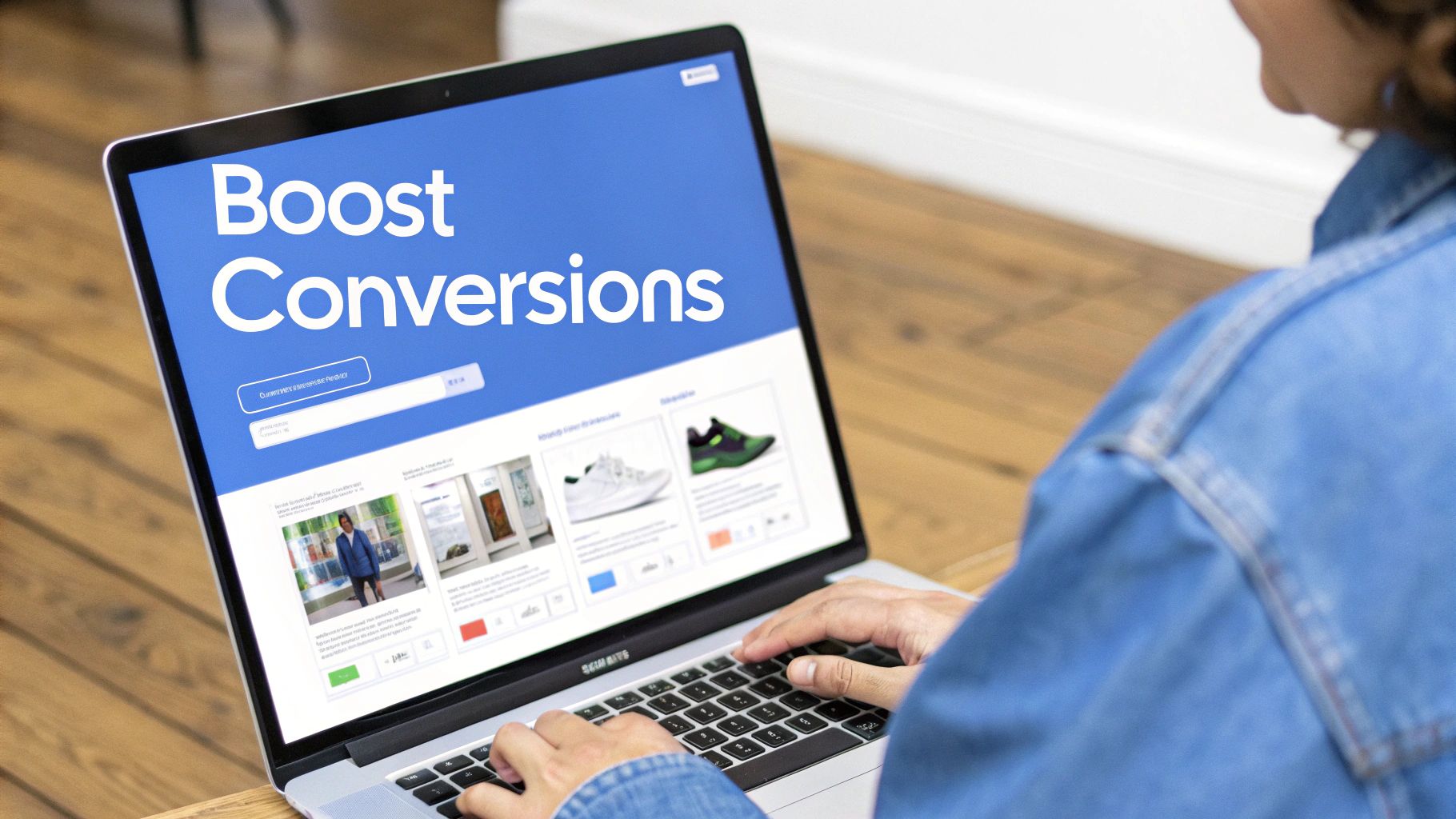
Ready to move from theory to action? This is where a dynamic content SEO strategy really starts to shine. The point isn't just to have a "smart" website; it's to deliver tangible results by giving people exactly what they're looking for, right when they're looking for it. Instead of shouting the same message at everyone, you get to have a one-on-one conversation.
We're going to walk through some powerful strategies you can put into play today. These methods are all about turning raw visitor data into a more relevant, engaging, and ultimately more successful user journey—which is precisely what Google loves to see.
Tailor Content Based on Visitor Location
One of the quickest wins in personalization is using a visitor's geographic location. This is a game-changer for businesses with a local footprint, instantly making your site feel more connected and genuinely helpful. Imagine a user lands on your site and the first thing they see is information specific to their city. That’s powerful.
This approach cuts right through the noise. A retail site, for example, could automatically show the nearest store's address, hours, and even what’s in stock locally. A service company could feature case studies or testimonials from the user's region, building immediate trust. That kind of local relevance is a huge signal of value to both users and search engines.
Differentiate for New and Returning Users
You wouldn't greet a stranger the same way you greet a good friend, right? Your website shouldn't either. Dynamic content lets you roll out the right welcome mat for first-time visitors and loyal customers, creating stronger connections that keep people coming back.
For brand-new visitors, you can:
- Show a Welcome Offer: Hit them with a first-time discount or a special deal to get that first conversion over the line.
- Provide an Introductory Video: A quick video explaining who you are and what you do can make a great first impression.
- Highlight Your Top Products: Don't make them guess. Guide new users toward your best-sellers to simplify their first visit.
For your returning fans, the goal is to deepen the relationship:
- Display Recently Viewed Items: Make it easy for them to pick up right where they left off.
- Offer Exclusive Perks: Show them loyalty rewards or exclusive content to make them feel like a VIP.
- Personalize Recommendations: Use their past behavior to suggest new things they'll genuinely love.
Customize Offers Based on Referral Source
Where a visitor came from tells you a lot about what they want. Did they click an ad for a specific product? Arrive from an email newsletter? Or find you through an organic search? Each path reveals a different mindset and intent.
By customizing the landing page to match the referral source, you create a seamless, consistent journey. When the message on the page perfectly aligns with the ad they just clicked, relevance skyrockets—and so do conversion rates.
If someone clicks an ad for "summer dresses," they should land on a page that’s all about summer dresses, not your generic homepage. It's that simple, yet so many sites get it wrong. For some killer inspiration, check out these high-impact dynamic landing page examples and see how leading brands nail this.
Navigating the Technical SEO Challenges
Rolling out a dynamic content strategy without sorting out the technical side is like building a house on a sand dune. Sure, personalization can give you a massive SEO boost, but it can completely backfire if search engines can't properly find, render, and index your pages. Getting the technical details right isn't just a good idea—it's everything.
One of the biggest landmines you need to sidestep is cloaking. This is the old-school practice of showing one thing to search engine bots and something entirely different to human visitors. Google hates it and will penalize you for it.
The key difference here is intent. Dynamic content is all about making the user experience better. Cloaking is about trying to game the search rankings. As long as your goal is to be helpful and Googlebot can still access a solid, default version of your content, you're in the clear.
Solving JavaScript Rendering and Indexing Issues
Many dynamic sites lean heavily on JavaScript to work their magic. Here's the catch: if Googlebot struggles to execute all that JavaScript, it might never even see the personalized content. Your best, most valuable content could end up being totally invisible to search engines.
This is where your rendering strategy becomes make-or-break.
- Server-Side Rendering (SSR): With SSR, the heavy lifting happens on the server. It builds the full HTML of the page—dynamic bits and all—before sending it to the browser. This means crawlers get a complete, ready-to-index page from the get-go.
- Dynamic Rendering: This is a hybrid approach that plays smart. It detects who's visiting—a bot or a person. It serves a pre-rendered, static HTML version to bots for easy indexing, while humans get the full interactive, client-side version.
Google's own documentation clearly shows how different rendering options work, highlighting how content gets from your site to their index. Server-side or dynamic rendering gives search engines the most direct, foolproof path to seeing everything on your page. So, which method is right for your site?
Maintaining Performance and Avoiding Penalties
To keep your site zippy and penalty-free, you need to be proactive. Start with the basics: optimize every image and set up browser caching to make things load faster for returning visitors. Using a Content Delivery Network (CDN) also makes a huge difference by serving your content from a location closer to your user.
Also, always use canonical tags to point to the "master" version of a page. This is absolutely critical when you use URL parameters to trigger dynamic content, because it stops duplicate content issues from watering down your SEO authority.
When you combine these technical fixes with smart tactics like dynamic keyword insertion on landing pages, you create an experience that's both powerful and SEO-friendly. And one last thing: are you checking your Core Web Vitals after every change? You should be.
How Mobile and Voice Search Change the Game

A solid dynamic content SEO strategy has to meet users where they are, and these days, that means on their phones and smart speakers. Just shrinking your desktop site onto a smaller screen is a surefire way to get high bounce rates and lose customers. The rules have changed, and your content needs to keep up.
This is where dynamic content becomes your secret weapon for creating a truly fluid mobile experience. We’re talking about more than just responsive design. It’s about intelligently swapping out large images for lighter ones to slash load times, simplifying navigation for easy thumb-scrolling, and even changing your calls-to-action.
Imagine a button that says "Request a Demo" on a desktop but instantly changes to a tappable "Call Us Now" on a smartphone. That's the kind of smart adaptation that search engines love to see. The data doesn't lie—mobile is king. A whopping 63.31% of all web traffic now comes from mobile devices, and only 11% of pages actually hold the same search rank on both desktop and mobile. Want to dive deeper? Check out the latest report from Digitalsilk.
Winning Voice Search with Dynamic Answers
Voice search is the next big wave, and it plays by a completely different set of rules. People aren't typing in clunky keywords; they're asking real, conversational questions. A dynamic content strategy is perfectly built for this, allowing you to serve up the direct, bite-sized answers that assistants like Siri and Alexa are designed to find.
Think about how you use voice search. You ask specific questions and expect instant answers.
- "Near Me" Searches: For location-based queries, dynamic content can instantly pull up the address, hours, and phone number for your closest physical store.
- Question-Based Searches: When someone asks a "how-to" or "what-is" question, you can dynamically feature a snippet of content formatted as a direct answer, making it ridiculously easy for a voice assistant to find it and read it aloud.
By structuring your content to provide these quick, conversational replies, you position your site as a primary source for voice search results. This isn't just good SEO; it's future-proofing your strategy for the way people will increasingly search for information.
Optimizing for voice is a massive opportunity. While 20.5% of the global population already uses it, a surprisingly low 13% of marketers are actively optimizing for it. Are you ready to claim that advantage?
Measuring the Impact of Your Dynamic SEO Strategy
So, you've set up a killer personalized experience. That's a huge first step, but how do you actually know if it's working? To justify all your hard work, you have to connect your dynamic content SEO strategy to real, tangible business results.
This means looking past simple vanity metrics like page views. We need to dig into the data that proves you’re making a real impact on the bottom line. The whole point is to measure how personalization is changing user behavior and helping your business grow.
If you aren't tracking the right key performance indicators (KPIs), you're basically flying blind. You won't know what to tweak or how to show the higher-ups that your strategy is delivering value. A data-driven approach isn't just a good idea—it's the only way to succeed.
Key Performance Indicators to Track
To get a crystal-clear picture of how your dynamic content is performing, you need to focus on metrics that directly tie into engagement and conversions. A tool like Google Analytics 4 is perfect for this. It lets you slice and dice your reports to see exactly how different user segments are responding to your personalized content.
Here are the big ones to keep an eye on:
- Conversion Rate: Are those personalized CTAs and offers actually leading to more sign-ups, leads, or sales? You need to track this for each specific user segment to know for sure.
- Average Session Duration: Are people who see dynamic content sticking around on your site longer? This is a fantastic indicator of genuine engagement.
- Bounce Rate: If you see a lower bounce rate on your personalized pages, it’s a great sign that your content is hitting the mark right away and grabbing visitors' attention.
- Pages Per Session: Dynamic content, like personalized recommendations, should naturally encourage people to explore more of your site. This metric tells you if it's working.
Using A/B Testing to Prove ROI
Honestly, the most powerful way to measure your impact is with a good old-fashioned A/B test. It’s simple: pit a static version of a page against a dynamic one and let the data tell the story. For example, you could test a generic headline against one that dynamically pulls in the user's city.
This kind of direct comparison cuts through the guesswork and gives you undeniable proof of what’s resonating with your audience.
Of course, solid measurement also means keeping a close watch on how your content is doing in the search results themselves. You can learn more about the importance of tracking SERPs to bridge the gap between your on-page efforts and your actual search visibility. When you connect these dynamic tests to concrete business goals, you can clearly show the ROI of your strategy.
Your Top Questions About Dynamic SEO, Answered
Alright, let's tackle some of the common questions that pop up when people start digging into dynamic content for SEO. Getting these cleared up from the start will give you the confidence to build a solid strategy.
Here are the straight answers to the questions we hear most often.
Is Dynamic Content Just a Fancy Name for Cloaking?
Not at all, as long as you're doing it to improve the user's experience. This is a big one. Cloaking is a black-hat tactic where you intentionally show search engines one thing and users a completely different thing, all in a shady attempt to manipulate rankings.
Dynamic content is different. The goal is to serve a more relevant version of the page to a specific user. As long as your intent is to be helpful—not deceptive—and Googlebot can still crawl a complete, valuable default version of the page, you're in the clear. Google is perfectly fine with it.
What Kind of Tools Do I Need for This?
The toolkit you'll need really depends on how deep you want to go and what your current tech stack looks like. The good news is, you don't have to break the bank to get started.
- CMS Platforms: Most of the big players like WordPress or HubSpot have plugins or built-in features that handle basic personalization.
- Dedicated Platforms: When you're ready to get more advanced, specialized tools like Optimizely or VWO offer powerful testing and personalization engines.
- Custom Solutions: If you have developers on hand, a custom JavaScript solution can give you ultimate control over every little detail.
Our advice? Start with what your current platform offers. You can always scale up to more sophisticated tools as your dynamic content strategy matures.
Will Dynamic Content Slow My Website Down?
It’s a valid concern. And yes, it can slow things down if you’re not careful, since it adds a bit more processing work for the server. But performance issues are 100% avoidable with the right approach.
To keep things speedy, you need to focus on clean code, have a fast hosting setup, and make good use of caching and a Content Delivery Network (CDN).
A pro-tip here is to look into server-side rendering (SSR). SSR does all the heavy lifting to build the personalized page before it even gets to the user's browser, which makes for a much faster experience. And no matter what, always keep an eye on your Core Web Vitals after you roll out any new dynamic features.
Ready to transform your post-click experience and boost conversions? LanderMagic empowers you to create high-performing, dynamic landing pages that connect with every visitor. Start for free and see the difference today!



